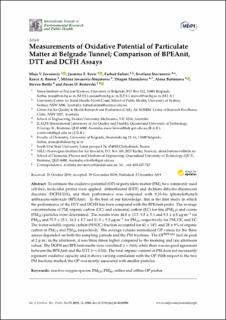Measurements of Oxidative Potential of Particulate Matter at Belgrade Tunnel; Comparison of BPEAnit, DTT and DCFH Assay
| dc.contributor.author | Jovanovic, Maja | |
| dc.contributor.author | Savic, Jasmina | |
| dc.contributor.author | Salimi, Farhad | |
| dc.contributor.author | Stevanovic, Svetlana | |
| dc.contributor.author | Brown, Reece A. | |
| dc.contributor.author | Jovasevic-Stojanovic, Milena | |
| dc.contributor.author | Manojlovic, Dragan | |
| dc.contributor.author | Bartonova, Alena | |
| dc.contributor.author | Bottle, Steven | |
| dc.contributor.author | Ristovski, Zoran | |
| dc.date.accessioned | 2020-02-18T12:07:59Z | |
| dc.date.available | 2020-02-18T12:07:59Z | |
| dc.date.created | 2020-02-05T09:40:27Z | |
| dc.date.issued | 2019 | |
| dc.identifier.issn | 1660-4601 | |
| dc.identifier.uri | https://hdl.handle.net/11250/2642267 | |
| dc.description.abstract | To estimate the oxidative potential (OP) of particulate matter (PM), two commonly used cell-free, molecular probes were applied: dithiothreitol (DTT) and dichloro-dihydro-fluorescein diacetate (DCFH-DA), and their performance was compared with 9,10-bis (phenylethynyl) anthracene-nitroxide (BPEAnit). To the best of our knowledge, this is the first study in which the performance of the DTT and DCFH has been compared with the BPEAnit probe. The average concentrations of PM, organic carbon (OC) and elemental carbon (EC) for fine (PM2.5) and coarse (PM10) particles were determined. The results were 44.8 ± 13.7, 9.8 ± 5.1 and 9.3 ± 4.8 µg·m−3 for PM2.5 and 75.5 ± 25.1, 16.3 ± 8.7 and 11.8 ± 5.3 µg·m−3 for PM10, respectively, for PM, OC and EC. The water-soluble organic carbon (WSOC) fraction accounted for 42 ± 14% and 28 ± 9% of organic carbon in PM2.5 and PM10, respectively. The average volume normalized OP values for the three assays depended on both the sampling periods and the PM fractions. The OPBPEAnit had its peak at 2 p.m.; in the afternoon, it was three times higher compared to the morning and late afternoon values. The DCFH and BPEAnit results were correlated (r = 0.64), while there was no good agreement between the BPEAnit and the DTT (r = 0.14). The total organic content of PM does not necessarily represent oxidative capacity and it shows varying correlation with the OP. With respect to the two PM fractions studied, the OP was mostly associated with smaller particles. | en_US |
| dc.language.iso | eng | en_US |
| dc.rights | Navngivelse 4.0 Internasjonal | * |
| dc.rights.uri | http://creativecommons.org/licenses/by/4.0/deed.no | * |
| dc.title | Measurements of Oxidative Potential of Particulate Matter at Belgrade Tunnel; Comparison of BPEAnit, DTT and DCFH Assay | en_US |
| dc.type | Peer reviewed | en_US |
| dc.type | Journal article | en_US |
| dc.description.version | publishedVersion | en_US |
| dc.rights.holder | © 2019 by the authors | en_US |
| dc.source.volume | 16 | en_US |
| dc.source.journal | International Journal of Environmental Research and Public Health | en_US |
| dc.identifier.doi | 10.3390/ijerph16244906 | |
| dc.identifier.cristin | 1790991 | |
| dc.relation.project | EC/FP7/308524 | en_US |
| cristin.unitcode | 7460,54,0,0 | |
| cristin.unitname | By og industri | |
| cristin.ispublished | true | |
| cristin.fulltext | original | |
| cristin.qualitycode | 1 |
Tilhørende fil(er)
Denne innførselen finnes i følgende samling(er)
-
Publikasjoner fra Cristin - NILU [1363]
-
Vitenskapelige publikasjoner [1098]
Vitenskapelige artikler, kapitler og monografier.

